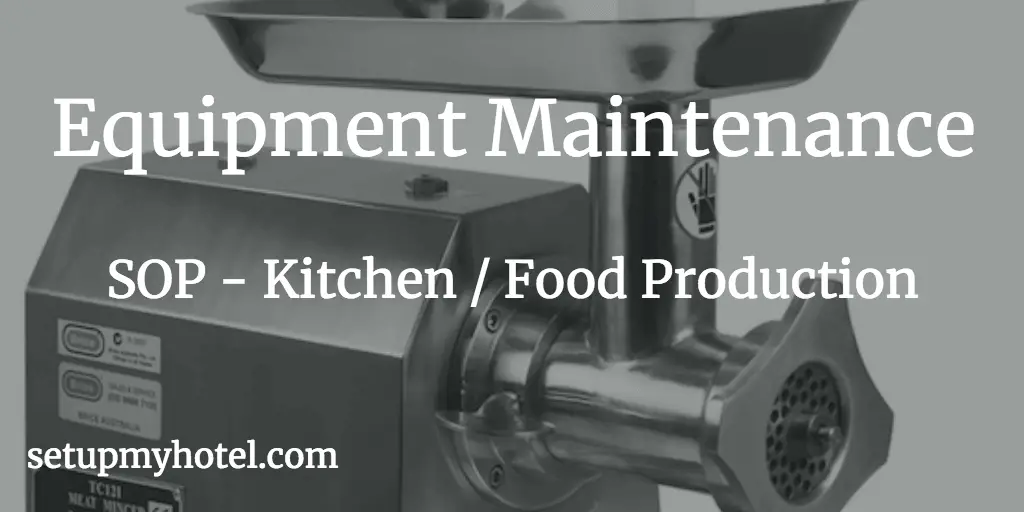Kitchen Equipment Handling and Maintaining
When working in a kitchen or F&B production environment, it is important to know how to handle, clean and sanitise the equipment. This is not only important for maintaining the quality of the food being produced, but also for ensuring the safety of those who consume it.
To begin, it is crucial to handle the equipment correctly. This means using the equipment for its intended purpose and following all safety guidelines. For example, using a knife to cut vegetables rather than using it to open a can. It is also important to be mindful of the condition of the equipment and to report any defects or malfunctions to the appropriate person.
Cleaning the equipment is another vital aspect of kitchen and F&B production. Proper cleaning not only ensures the equipment is free of contamination but also prolongs its lifespan. It is important to use the correct cleaning products and follow the manufacturer’s instructions. Additionally, it is important to clean equipment immediately after use to prevent the buildup of dirt and bacteria.
Finally, sanitising the equipment is essential to prevent the spread of harmful bacteria and other microorganisms. This involves using a sanitiser to kill any remaining bacteria or germs on the equipment. It is important to follow the correct procedures for sanitising, as using the wrong sanitiser or method can be ineffective and even harmful.
By following these guidelines for equipment handling, cleaning and sanitising, those working in a kitchen or F&B production environment can ensure the safety and quality of the food being produced.
The Kitchen Staff/chefs who use such equipment will be responsible for washing and sanitizing removable parts after each use. Equipment that handles potentially hazardous or easily contaminated foods is cleaned at least every eight hours.
Kitchen Equipment Maintenance Standard Procedures:
- Ensure that all hand-washing sink areas are supplied with soap dispensers and disposable towels or functioning air dryers at all times.
- Maintain walk-in and deep freezer facilities so that they function properly and are clean.
- See Temperature Record for Freezer, Temperature Record for Freezer/Refrigerators, and Temperature Record for Refrigerator.
- Take temperatures routinely of water used in the kitchen to ensure that hot (minimum 45º CelsiusCelsius - The thermometric scale on which 0� Celsius is the freezing point and 100� Celsius is t...) and cold (20º Celsius) running water is available at all sinks.
- Check to make sure that there is no possibility of back siphonage in the kitchen sinks and drains.
- Check to make sure that all food waste and rubbish are stored in rodent and insect-proof containers with tight-fitting lids.
- Make sure that temperatures of all cooling equipment are taken and recorded routinely to ensure proper calibration of thermometers and proper equipment operation.
- Make sure that temperatures of all heating equipment are taken and recorded routinely to ensure proper functioning and thermometer calibration.
- Record temperatures of holding equipment at least daily to ensure proper functioning and calibration.
- Monitor the maintenance of ventilation systems, ensuring that systems are adequate and regularly cleaned according to the recommended schedule.
- Assure all equipment in the kitchen area is well maintained.
- The executive chef should make sure to contract with an equipment repair company to have preventive maintenance done for all equipment, including calibration of cooking equipment.
- The kitchen staff or the engineering team should make sure to log all preventative and repair work maintenance.
- Review temperature logs to ensure that they are being done and to determine problem areas.
- The Executive Chef or Sous Chef should follow up on any equipment issues or needs.
- Maintain all facility and equipment documentation with HACCPHazard Analysis and Critical Control Points (HACCP) A systematic approach to the identification; eva... records.
Kitchen Equipment Cleaning and Sanitising:
- All equipment used in the kitchen area should be washed, rinsed, and sanitized after each use to ensure the safety of food served to customers.
- Make sure to disassemble removable parts from the equipment.
- Use the three-sink method to wash, rinse, and sanitize all parts.
- Verify sanitiser concentration for each meal period and as necessary per policy.
- WashWash - 1) Brushing or coating a food item with a liquid such as egg white; milk or egg wash. 2) The ..., rinse, and sanitize all food contact surfaces of the stationary equipment.
- Allow all parts of the equipment to air dry.
- Make sure to re-assemble the equipment once dried.
Training Summary questions:
Q1. What is the purpose of this SOP?
Q2. Who is responsible to check and monitor equipment maintenance activities in the kitchen?
Q3. Explain the guidelines for equipment cleaning on the kitchen premises.
Q4. What should be the ideal temperature for water used in the kitchen?
Q5. Why it is important to prevent the back siphonage in the kitchen area?
Patreon Only SOP Download
SOP Number: Kitchen / F&B Production SOP – 5 Department: Kitchen / Food Production - Equipment Handling Date Issued: 12-Sep-2018 Time to Train: 30 Minutes












